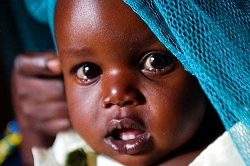Net Advantage
Study finds use of bed nets by 75 percent of population could eradicate malaria
07 March 2013

Malaria, the leading cause of death among children in Africa, could be eliminated if three-fourths of the population used insecticide-treated bed nets, according to a new study from the National Institute for Mathematical and Biological Synthesis (NIMBioS).
The study, which uses a mathematical model, found that use of insecticide-treated bed nets or ITNs positively affected the infection's reproduction number, or R, which is the primary epidemiological number used to determine the degree which a disease can spread through a population. The model concludes that if 75 percent of the population were to use ITNs, malaria could be eliminated.
The treated mosquito net forms a protective barrier around people sleeping under them. The insecticide not only kills the mosquitoes, which carry the malaria parasite, and other insects, it also repels mosquitoes, reducing the number that enter the house and attempt to feed on people inside. With ITNs, the number of mosquitoes, as well as their length of life, is reduced, which is why the density of nets in a community is important.
Overcoming cultural resistance to using bed nets in communities where people view the nets as intrusive has been a major challenge of international malaria prevention agencies, however. There is evidence also that in some countries more bed nets go to the rich than the poor. Health groups are devising strategies to encourage use of the bed nets and to make sure they are distributed more equitably.
"Based on the results, it’s clear that educational campaigns around the use of bed-nets must continue as the nets play a critical role in reducing the transmission of malaria," said Folashade Agusto, the study's lead author and participant in the NIMBioS Investigative Workshop on Malaria Modeling and Control, whose other participants co-authored the study. A former NIMBioS postdoctoral fellow, Agusto is an assistant professor of mathematics at Austin Peay State University.
Malaria has already been eradicated in Europe, North America, the Caribbean, and parts of Asia and South-Central America, and yet, the World Health Organization estimates that every year 250 million people become infected with malaria and nearly one million die.
Citation: Agusto FB, Del Valle SY, Blayneh KW, Ngonghala CN, Goncalves MJ, Li N, Zhao R, Gong H. 2013. The impact of bed-net use on malaria prevalence. Journal of Theoretical Biology 320:58-65. [Online]
Contact Information: Catherine Crawley, NIMBioS, ccrawley@nimbios.org; 865-974-9350
#
The National Institute for Mathematical and Biological Synthesis (NIMBioS) brings together researchers from around the world to collaborate across disciplinary boundaries to investigate solutions to basic and applied problems in the life sciences. NIMBioS is supported by the National Science Foundation, the U.S. Department of Homeland Security, and the U.S. Department of Agriculture with additional support from The University of Tennessee, Knoxville.
NIMBioS
1122 Volunteer Blvd., Suite 106
University of Tennessee
Knoxville,
TN 37996-3410
PH: (865) 974-9334
FAX: (865) 974-9461
Contact NIMBioS


